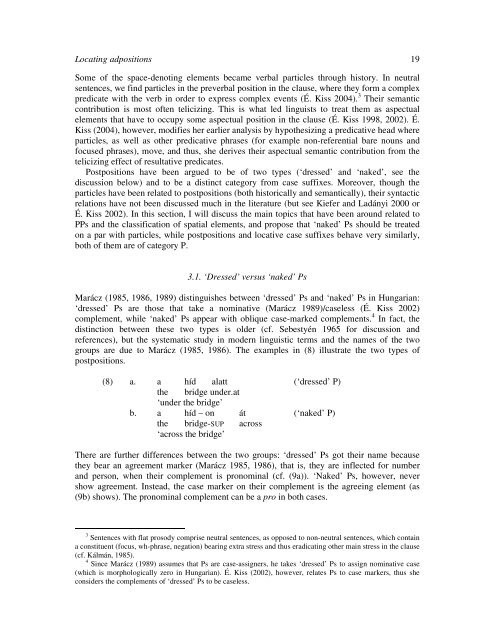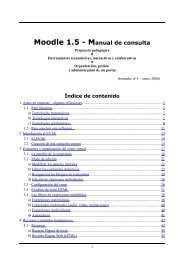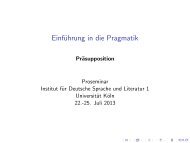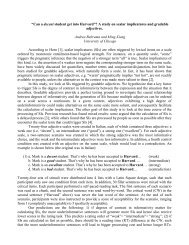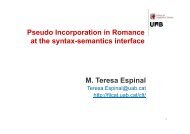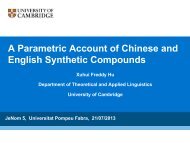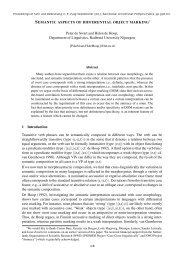Locating adpositions. - corpora@parles.upf
Locating adpositions. - corpora@parles.upf
Locating adpositions. - corpora@parles.upf
You also want an ePaper? Increase the reach of your titles
YUMPU automatically turns print PDFs into web optimized ePapers that Google loves.
<strong>Locating</strong> <strong>adpositions</strong> 19<br />
Some of the space-denoting elements became verbal particles through history. In neutral<br />
sentences, we find particles in the preverbal position in the clause, where they form a complex<br />
predicate with the verb in order to express complex events (É. Kiss 2004). 3 Their semantic<br />
contribution is most often telicizing. This is what led linguists to treat them as aspectual<br />
elements that have to occupy some aspectual position in the clause (É. Kiss 1998, 2002). É.<br />
Kiss (2004), however, modifies her earlier analysis by hypothesizing a predicative head where<br />
particles, as well as other predicative phrases (for example non-referential bare nouns and<br />
focused phrases), move, and thus, she derives their aspectual semantic contribution from the<br />
telicizing effect of resultative predicates.<br />
Postpositions have been argued to be of two types (‘dressed’ and ‘naked’, see the<br />
discussion below) and to be a distinct category from case suffixes. Moreover, though the<br />
particles have been related to postpositions (both historically and semantically), their syntactic<br />
relations have not been discussed much in the literature (but see Kiefer and Ladányi 2000 or<br />
É. Kiss 2002). In this section, I will discuss the main topics that have been around related to<br />
PPs and the classification of spatial elements, and propose that ‘naked’ Ps should be treated<br />
on a par with particles, while postpositions and locative case suffixes behave very similarly,<br />
both of them are of category P.<br />
3.1. ‘Dressed’ versus ‘naked’ Ps<br />
Marácz (1985, 1986, 1989) distinguishes between ‘dressed’ Ps and ‘naked’ Ps in Hungarian:<br />
‘dressed’ Ps are those that take a nominative (Marácz 1989)/caseless (É. Kiss 2002)<br />
complement, while ‘naked’ Ps appear with oblique case-marked complements. 4 In fact, the<br />
distinction between these two types is older (cf. Sebestyén 1965 for discussion and<br />
references), but the systematic study in modern linguistic terms and the names of the two<br />
groups are due to Marácz (1985, 1986). The examples in (8) illustrate the two types of<br />
postpositions.<br />
(8) a. a híd alatt (‘dressed’ P)<br />
the bridge under.at<br />
‘under the bridge’<br />
b. a híd – on át (‘naked’ P)<br />
the bridge-SUP across<br />
‘across the bridge’<br />
There are further differences between the two groups: ‘dressed’ Ps got their name because<br />
they bear an agreement marker (Marácz 1985, 1986), that is, they are inflected for number<br />
and person, when their complement is pronominal (cf. (9a)). ‘Naked’ Ps, however, never<br />
show agreement. Instead, the case marker on their complement is the agreeing element (as<br />
(9b) shows). The pronominal complement can be a pro in both cases.<br />
3 Sentences with flat prosody comprise neutral sentences, as opposed to non-neutral sentences, which contain<br />
a constituent (focus, wh-phrase, negation) bearing extra stress and thus eradicating other main stress in the clause<br />
(cf. Kálmán, 1985).<br />
4 Since Marácz (1989) assumes that Ps are case-assigners, he takes ‘dressed’ Ps to assign nominative case<br />
(which is morphologically zero in Hungarian). É. Kiss (2002), however, relates Ps to case markers, thus she<br />
considers the complements of ‘dressed’ Ps to be caseless.


